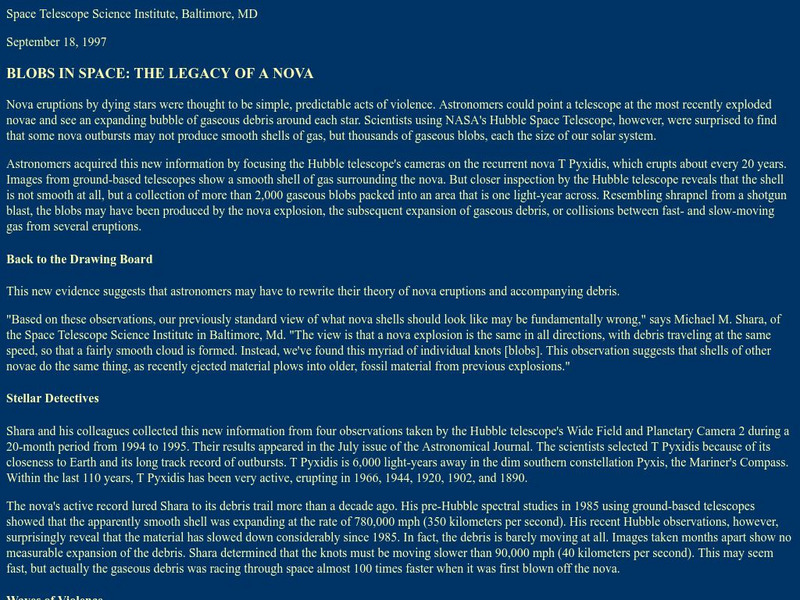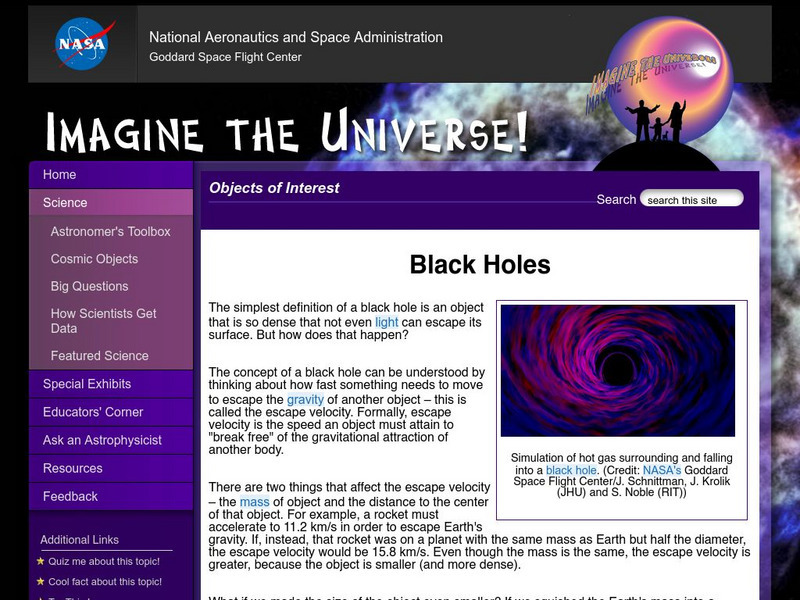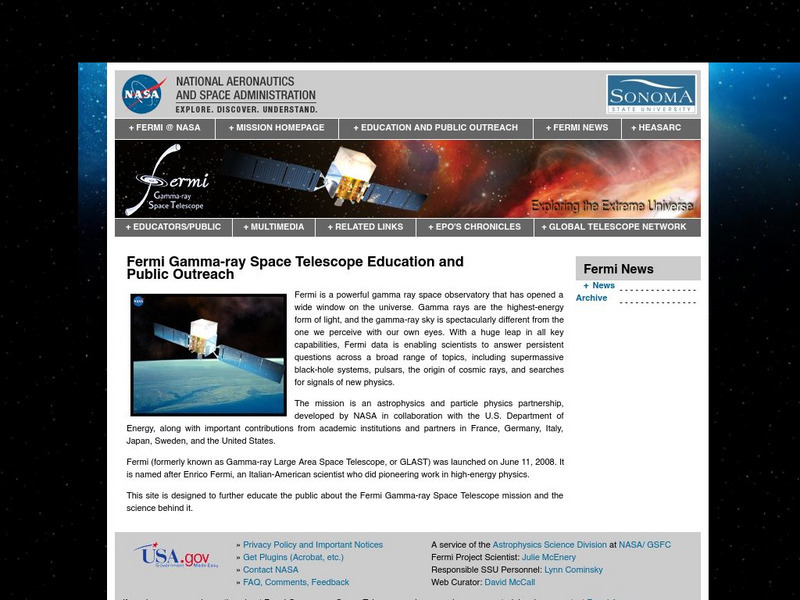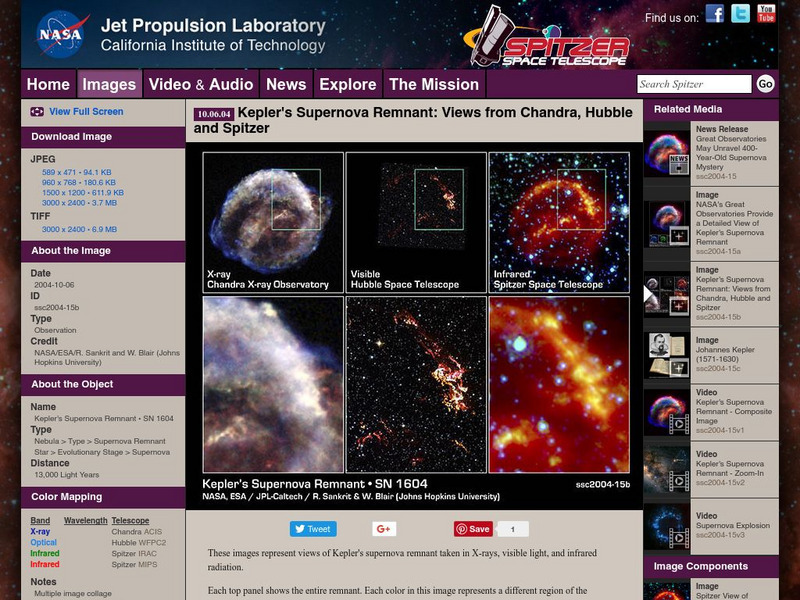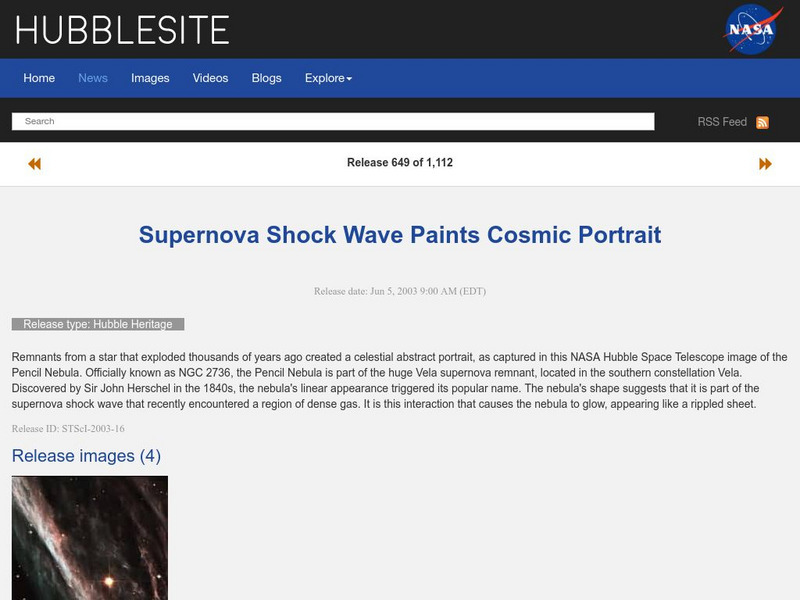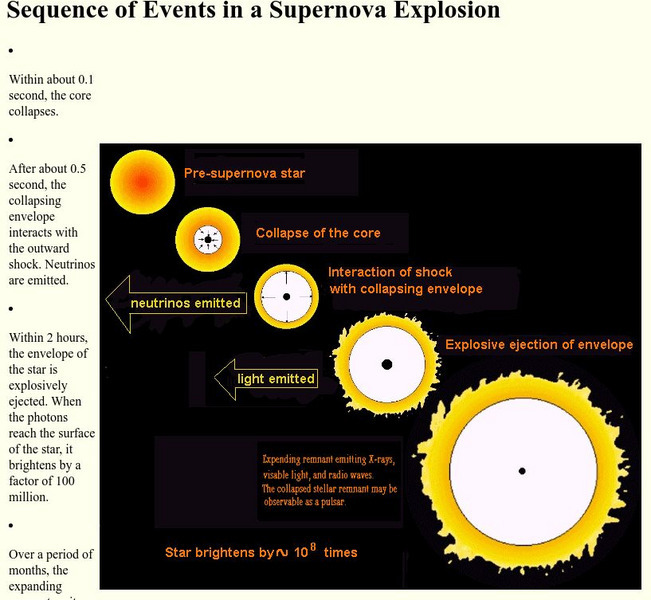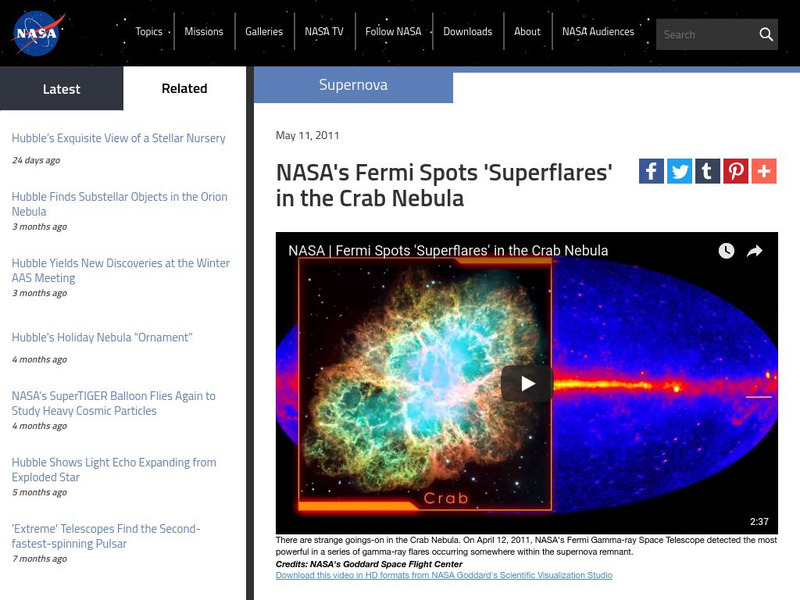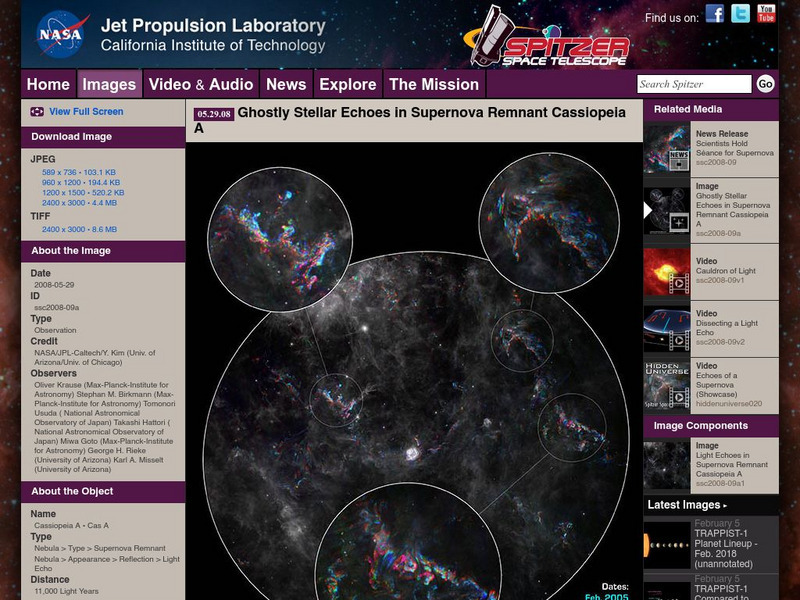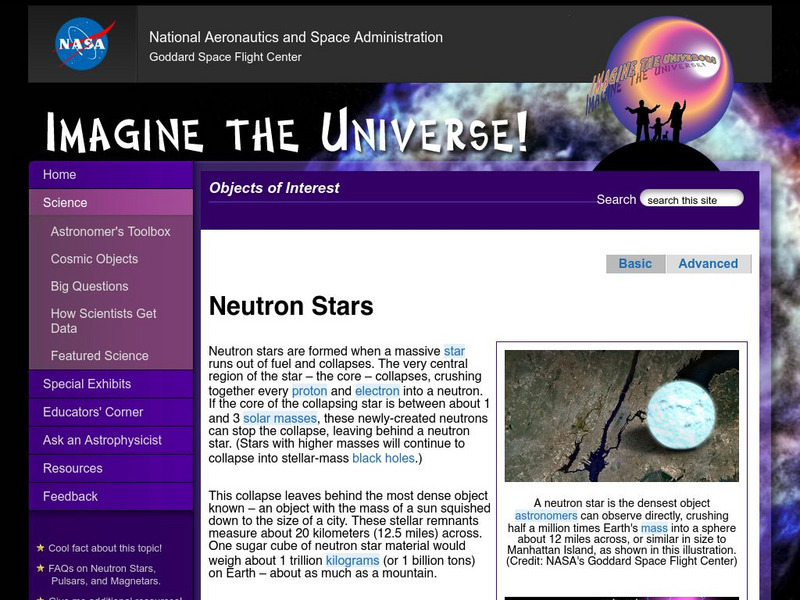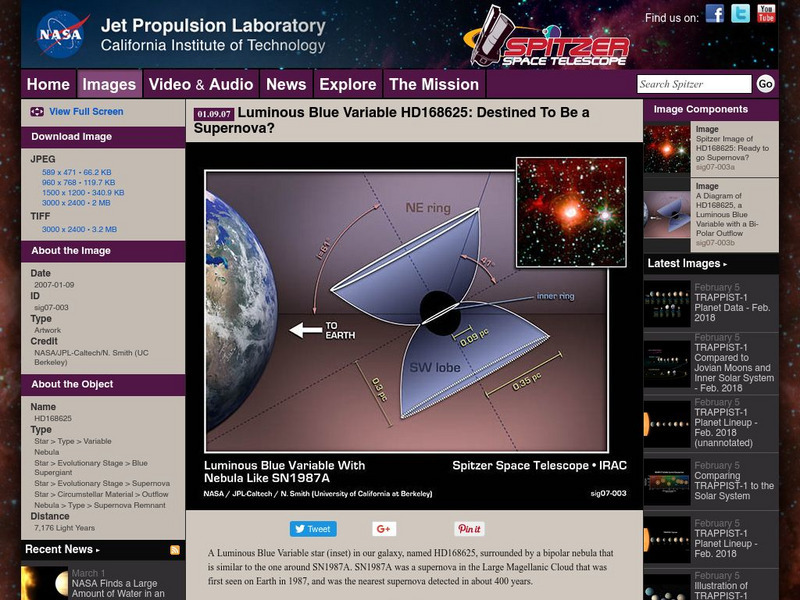Hi, what do you want to do?
PBS
Pbs Teachers:monster of the Milky Way: Birth of a Black Hole
Discover how a dying star can be reborn as a black hole. View a slide show that follows the progression of events from an old, dying star to newborn black hole.
PBS
Pbs: Nova Online: Birth of a Supernova
PBS site explores the birth of a Supernova and explores its common types.
CK-12 Foundation
Ck 12: Earth Science: Supergiants and Supernovas
[Free Registration/Login may be required to access all resource tools.] Explain the importance of supernovas and how a star becomes a supergiant.
TED Talks
Ted: Ted Ed: How to Detect a Supernova
Just now, somewhere in the universe, a star exploded. In fact, a supernova occurs every second or so in the observable universe. Yet, we've never actually been able to watch a supernova in its first violent moments. Is early detection...
NASA
Nasa: Imagine the Universe: Gamma Rays From Supernovae and Supernova Remnants
Astronomers use gamma decay to study the lives of the stars.
Other
Astronet: Blobs in Space: The Legacy of a Nova
The expansion and explosion of a star is described at it goes through its nova phase. Current theories are discussed.
NASA
Nasa: Imagine the Universe: Black Holes
Learn what black holes are and the myths that surround them.
NASA
Astronomical Society of the Pacific: Telescope Treasure Hunt
This hands-on astronomy activity lets learners hunt for different objects in the night sky that contribute to stellar and planetary formation, using a Treasure List. They will learn how stars and their planets form and will find objects...
NASA
Nasa: Imagine the Universe: The History of Gamma Ray Astronomy
This NASA article discusses the history of gamma-ray astronomy. Related resources.
NASA
Nasa: Wmap: Fate of the Universe
A general look at the expansion of the universe and the Big Bang theory.
BBC
Bbc: Gcse Bitesize: The Life Cycle of a Star
This lesson focuses on the formation and life cycle of stars. Stars form when enough dust and gas clump together because of gravitational forces. Nuclear reactions release energy to keep the star hot. Some stars grow larger over time....
Sonoma State University
The Gamma Ray Large Area Space Telescope (Glast)
Background information on gamma rays and the sources of gamma rays in the universe. Discusses the purpose of the GLAST space mission and the types of findings which they wish to make. A link to the GLAST movie provides an excellent...
PBS
Pbs: Nova Online: History of the Universe
PBS site explores the history of the Universe by providing users with a Universe Timeline exploring different theories. Site also contains links to a tour of the Universe, birth of a Supernova, additional resources and much more.
NASA
Nasa: Imagine the Universe: Welcome to the World of X Ray Astronomy
Site recounts how X-rays were discovered as well as who discovered them. Offers graphics, links to facts on this topic, a quiz, and teacher resources.
California Institute of Technology
Spitzer Science Center: Kepler's Supernova Remnant
This image, titled "Kepler's Supernova Remnant: Views from Chandra, Hubble and Spitzer" features six individual pictures of Kepler's supernova taken with different types of equipment (x-rays, infrared, etc). The text under the image...
Space Telescope Science Institute
Hubble Site: Supernova Shock Wave
This site from the Hubblesite highlights an article written about a supernova shock wave. Provides images as well as video footage. Site offers links to fast facts, a question and answer section as well as related links.
Cornell University
Cornell University: Astronomy: Sequence of Events in a Supernova Explosion
The complex sequence of events in a supernova explosion are explained and illustrated.
Australian Broadcasting Corporation
Australian Broadcasting Corporation: News in Science: Supernova Caught on Camera
From ABC News in Science, Richard Ingham's article explores information relating to footage of the explosion of a star. The article also deals with what happens in the aftermath of a supernova.
NASA
Nasa: Crab Nebula Supernova Remnant
The Crab Nebula Supernova Remnant image is part of a series of photographs taken from the Spitzer Space Telescope. The picture is accompanied by a textual overview of a nebula left over from a supernova explosion. Specific attention is...
University of Illinois
University of Illinois: Stars and Constellations: White Dwarf Supernovae
Discusses the formation of the white dwarf and the role this star plays in the formation of a white dwarf supernovae.
NASA
Nasa: Imagine the Universe: Welcome to the World of Multiwavelength Astronomy!
This Imagine the Universe site provides an introduction into the multiwavelength universe and astronomy. Site provides graphics, links to a quiz, facts on this topic as well as teacher resources.
California Institute of Technology
Spitzer Science Center: Image of an Infrared Echo
The Infrared Echo, featured this space telescope image of the supernova remnant of Cassiopeia A, is created when a star explodes. A detailed textual overview explains various specifics of the picture.
NASA
Nasa: Imagine the Universe: Neutron Stars and Pulsars
Discover what neutron stars and pulsars are and view pictures of them. Includes links to additional resources and lesson plans.
California Institute of Technology
Spitzer Science Center: Luminous Blue Variable
In examining the "Luminous Blue Variable" this site seeks to determine if the blue variable is "Destined To Be a Supernova." An image (or chart) is provided along with a brief description of the details of the picture.










